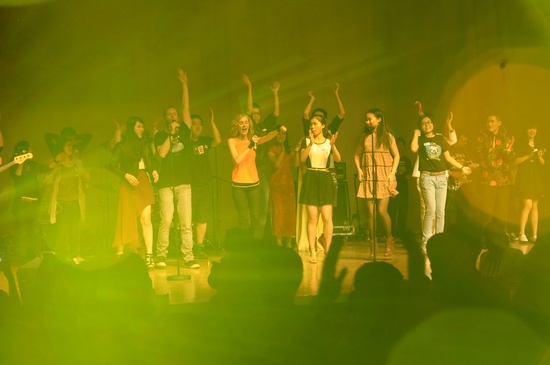
Gala of Artists from Different Countries. Photo by Yang Shutian

Fly By Wire Rock and Roll Covers Band of Australia performanced in Beijing Foreign Studies University. Photo by Yang Shutian
With a glimpse of time, it is already the age of information and all the people live together in a global village, which makes it possible for various cultures to exchange with each other. The previous eight sessions of China International Folk Arts Festival (CIFAF) sponsored by CFLAC have brought folk arts of the world together in China—the stage of global folk arts—for Chinese people’s appreciation and better understanding. On this occasion, China has exchanged with other countries in folk arts and many foreign countries have exchanged with each other in China.
This year the 9th CIFAF took place in Yichang of Hubei Province and Beijing and accumulated over 300 folk artists from 13 foreign countries of the five continents. On the basis of previous sessions, the 9th CIFAF has its most significant character in its closeness to audience and public. The main stage was located in squares, communities, parks and schools so that artists would have direct contact, exchange and interaction with ordinary audiences. The arrangement of Chinese folk arts and visiting folk art troupe’s performance on the same stage aims to showcase the charm of national folk arts and enable Chinese people to enjoy the colorful multi-element cultures all over the world. This is indeed the right way of respecting and protecting folk arts and the most direct and effective measure to develop folk arts and promote peace and friendship. Only in this way can CIFAF gain its lasting power of life.
The folk arts have its root and origins in folk, so it has a strong advantage of affinity with ordinary people. The participation and interaction of mass people is the very nature of folk arts.
Without enclosing walls or admission, folk arts entered the square. Then people would feel that the arts belong to them with extreme familiarity and even that they are actually part of the performance. Having enjoyed exotic song and dance and magnificent costumes, Chinese people couldn’t help stepping onto the stage to join those artists. The Turnabout Dance from Egypt had beautiful poses and subtle implication of global rotation and returning, and even some religious elements could be sensed. A Cappella chorus performance from Mexico brought us to realize that human voice is the most perfect musical instrument. Moreover, Maogusi Dance, Hair Dance and Stool Dragon in Hubei Province amazed the visiting artists as well. All above effect was hard to imagine in a professional theatre.
When folk artists entered the community and resident’s courtyard, the host would feel as close as their relatives pay a guest visit. Today residents were able to view the rhythm and elegance in Flamingo Dance of Spain and enjoy the magnificent costumes and changing gestures of Russian Dance Company. At last Russian folk artists’ free-style passion aroused their own bold expressions and Czech New Soldiers Dance led them to experience good order and youthful spirits.
When folk arts entered a park where citizens were roaming in this graceful environment, the sound of music will naturally gather so many audiences around without any publicity. In this open-air stage, the high artistic standard and visual enjoyment by Polish Dance Company aroused audiences’ acclamation, various cultural elements embodied in Pakistani dance brought the audiences into deep thinking and Black African Indigenous Dance presented experience in passion. The drop temperature in Beijing hardly changed the citizens’ enthusiasm in appreciation and participation.
The folk arts also entered the campus and get in touch with the future heir of culture—students. The 32-member from the Utah Valley University Ballroom Dance Company of USA met with their counterparts and exchange dance skills at Three Gorges University while the Australian Fly by Wire Band brought the performance to a climax by singing their version of the most popular song in China, The Most Dazzling National Fashion. The steel drum adapted from petrol bucket by Trinidad and Tobago Steel Symphony Orchestra gave a cool idea while dance from Senegal made their blood boiling over. Through these, the students came to understand the perfect pair of national element and modern feature and the importance of originality in culture. At school, such a youthful place, it is crucially important for those students to learn more about and have a liking of folk arts, which will play a key role in the development of folk arts.
Without folk there would never be folk culture; without folk culture the multi-element world culture would be out of the question. Without such a multi-element culture, what a dull boring and senseless life we would be leading!
Only with folk can folk arts convey happiness;
Only deep into the public can folk arts realize its charm;
Only into folk hearts can folk arts become immortal.
(The author is Doctor of Nationality Studies and planner of CAEG. )














